Are your campaigns performing well but you think they could do more? Want to kick things up a notch without paying a ton per click?
In this article, you'll learn six ways to improve your Facebook advertising for better results.

#1: Carefully Increase Your Facebook Ad Budget
Let's say you launched a lead generation campaign on Facebook. At first, the cost per lead was on the high side. But after a few days, ad delivery stabilized, the ad set left the learning phase, and the cost per lead settled comfortably into your target range.
Now the campaign has been running for a few weeks. Performance continues to stay consistent, and the return on ad spend (ROAS) and cost per 1,000 impressions (CPM) are right where your team wants them to be. Ideally, you'd get more leads for the same cost so you're thinking about allocating a bigger budget. In other words, you want to scale vertically.

It's reasonable to expect that increasing the spend on a successful campaign would let you secure more leads at a similar cost per result. Yet in reality, aggressively increasing an ad budget often compromises campaign performance. That's why it's important to take a measured approach to vertical scaling.
Avoid the Learning Phase
If you scale your budget too quickly, Facebook can't keep delivering your ads to the same high-performing audience at the same rate. Instead, the platform has to re-optimize ad delivery quickly, given the new campaign settings. That typically means ad sets return to the learning phase, which allows the Facebook algorithm to collect the data it needs to deliver your ads efficiently.
Because the learning phase tends to be the most expensive and unpredictable part of a campaign, the cost per result can increase significantly. Even after performance stabilizes and the ad set leaves the learning phase again, there's no guarantee that the new cost per result will resemble what it was before increasing the budget.
Scale Spend Slowly
To avoid compromising your cost per lead or decreasing ROAS, scale your ad spend slowly. Aim to increase the budget by 10%-20% per week to avoid the learning phase. That way, you can continue to expand your campaign's reach and get more leads while allowing Facebook to deliver your ads efficiently.

To make sure you're getting the results you want, watch the cost per result closely. This metric is likely to increase over time, even if you raise the budget slowly. You may need to use one of the horizontal scaling tactics below to keep your campaign on track as you increase spend.
Turn on Campaign Budget Optimization
When you run a campaign that has multiple ad sets, you may want to set a separate budget for each one. Naturally, this approach gives you more control over how much you spend to reach your target audiences.
But this tactic doesn't always allow successful scaling. When you specify ad set budgets, Facebook may not be able to deliver ads as efficiently. That means you could pay more than necessary for results or end up with a lower ROAS than you'd like.
To increase efficiency and improve performance, use Facebook Ads' campaign budget optimization option. When you turn on this option at the campaign level, you let the algorithm determine how to allocate your budget across ad sets. That means Facebook can automatically spend more on high-performing ad sets and less on low-performing ad sets.
To use this setting, go to the Campaign Budget Optimization section of your campaign and toggle the switch to On. Then enter the budget for the campaign. Once you publish the changes, you can continue to edit the budget at the campaign level.

For best results, use campaign budget optimization whenever you scale campaigns vertically. That way, you can increase the campaign budget gradually while allowing Facebook to optimize spend across ad sets automatically.
Get World-Class Marketing Training — All Year Long!
Are you facing doubt, uncertainty, or overwhelm? The Social Media Marketing Society can help.
Each month, you’ll receive training from trusted marketing experts, covering everything from AI to organic social marketing. When you join, you’ll also get immediate access to:
- A library of 100+ marketing trainings
- A community of like-minded marketers
- Monthly online community meetups
- Relevant news and trends updates
#2: Set Facebook Ads Bids Manually
Facebook campaigns typically perform best when you give the algorithm ample opportunity to optimize delivery. That's why tactics like switching on campaign-based budgets and using the default bid strategy both tend to be great for scaling.
But sticking with the default bid strategy isn't optimal if you need more control over costs or returns. So how can you manipulate these elements manually while scaling vertically? Use one of the advanced bid strategies to get the results you want.
Minimum ROAS
With the minimum ROAS bid strategy, Facebook aims to meet or exceed the ROAS floor you set, giving you more control over the return on your ads. It's ideal for getting a consistent return, even as you scale your campaigns.
This bid strategy works best when you have a lot of data to use for estimating conversion rates and calculating net costs. Minimum ROAS also requires frequent manual bid adjustments to ensure that your ads don't stop delivering. You'll need to check regularly to ensure the ROAS is high enough to meet your goals but low enough for efficient delivery.
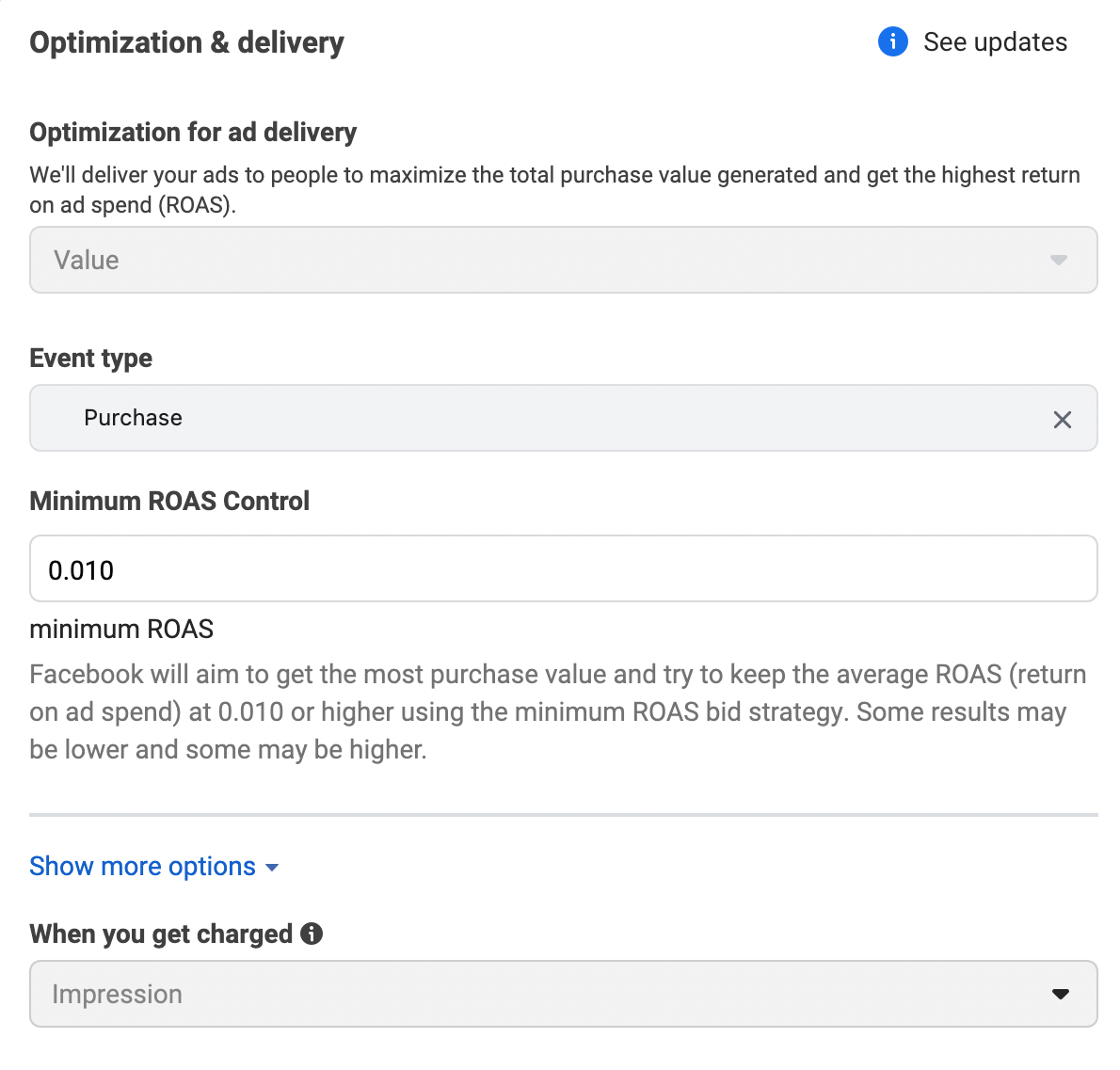
Bid Cap
With the bid cap strategy, you determine the maximum amount you want to spend in an ad auction. It's ideal for maximizing results while maintaining control over advertising costs.

As an advanced bid strategy, bid cap works best if your team has prior experience with pay-per-click (PPC) ads and knows how to set and adjust bids. Like minimum ROAS, bid cap requires regular checks to ensure your bid is high enough to optimize delivery as you scale but low enough to reach your key performance indicators (KPIs).
#3: Update Your Facebook Ads Audience Targeting
Expanding target audiences has historically been a smart way to scale horizontally. Naturally, this tactic lets you reach more people and drive more results. But since early 2021, Facebook has gradually been dialing back advertisers' abilities to reach specific target audiences:
- In mid-2021, the platform implemented aggregated event measurement, changing the way Facebook tracks iOS 14 users and restricting the number of website and app events advertisers can target.
- In early 2022, the platform eliminated numerous detailed targeting options, severely limiting opportunities to create interest-based audiences.
If you've been advertising to the same types of audiences since early 2021, you may struggle to reach your goals or scale successfully. Updating your target audiences can help you reach more of the right people at every stage of the funnel, even with Facebook's new limitations.
Expand Your Reach With Broad Targeting
Do you typically use interest-based audiences for top-of-funnel campaigns? Narrowly defined audiences have become tougher to target, which may limit their reach and make scaling unnecessarily difficult or overly expensive.
Rather than building a highly targeted audience, try broad targeting instead. You can use gender, age, and location settings to create the most broadly defined audience possible. Then you can rely on the Facebook algorithm to deliver your ads to the people who are most likely to convert.
To give the algorithm even more opportunities to serve your ads, you can turn on Detailed Targeting Expansion at the ad set level. This setting allows Facebook to deliver your ads beyond the parameters you set if it's likely to get better results.

Discover Proven Marketing Strategies and Tips
Want to go even deeper with your marketing? Check out the Social Media Marketing Podcast! Publishing weekly since 2012, the Social Media Marketing Podcast helps you navigate the constantly changing marketing jungle, with expert interviews from marketing pros.
But don’t let the name fool you. This show is about a lot more than just social media marketing. With over 600 episodes and millions of downloads each year, this show has been a trusted source for marketers for well over a decade.

Reconsider Remarketing Audiences
Remarketing to engaged prospects is still a great option for middle- and bottom-of-funnel campaigns. But relying on website-based remarketing audiences may not be as helpful as it once was, due to iOS 14 tracking issues.
If you're struggling to scale with a website-based audience, consider using a customer list or Facebook data instead. For example, you can build remarketing audiences based on your:
- Facebook catalog, including people who viewed, purchased, or added products to their cart
- Lead form, including people who opened or submitted your instant form
- Page, including people who visited your business's profile, engaged with content, or sent your page a message
- Videos, including people who watched certain amounts or percentages of specific videos

Build Lookalike Audiences
To scale ad campaigns effectively, it's important to have a large audience of potential customers. Using lookalike audiences can help you connect with more people who are likely to be interested in your business, helping you get better results while keeping costs in check.
Choose the seed for your lookalike audience wisely, prioritizing well-vetted or high-value data sources. For example, you can use your Facebook pixel to create a value-based lookalike audience of people similar to those who purchased from your business. Alternatively, you can create a lookalike based on a segment of your most loyal customers.
When you first create a lookalike, start with a 1% audience to find people most like the seed audience. As you continue to scale your campaigns, you can build bigger lookalikes (up to 10%) that allow you to reach more people like your customers.

#4: Leverage All Available Placements
To scale horizontally, it's also important to reach your target audience in as many places as possible. Facebook typically recommends using automated placements so the algorithm can deliver your ads wherever it's most likely to generate results.
That means targeting all devices and operating systems and avoiding any content or topic exclusions. It also means using Facebook's standard inventory for in-stream videos, Instant Articles, and Audience Network content.
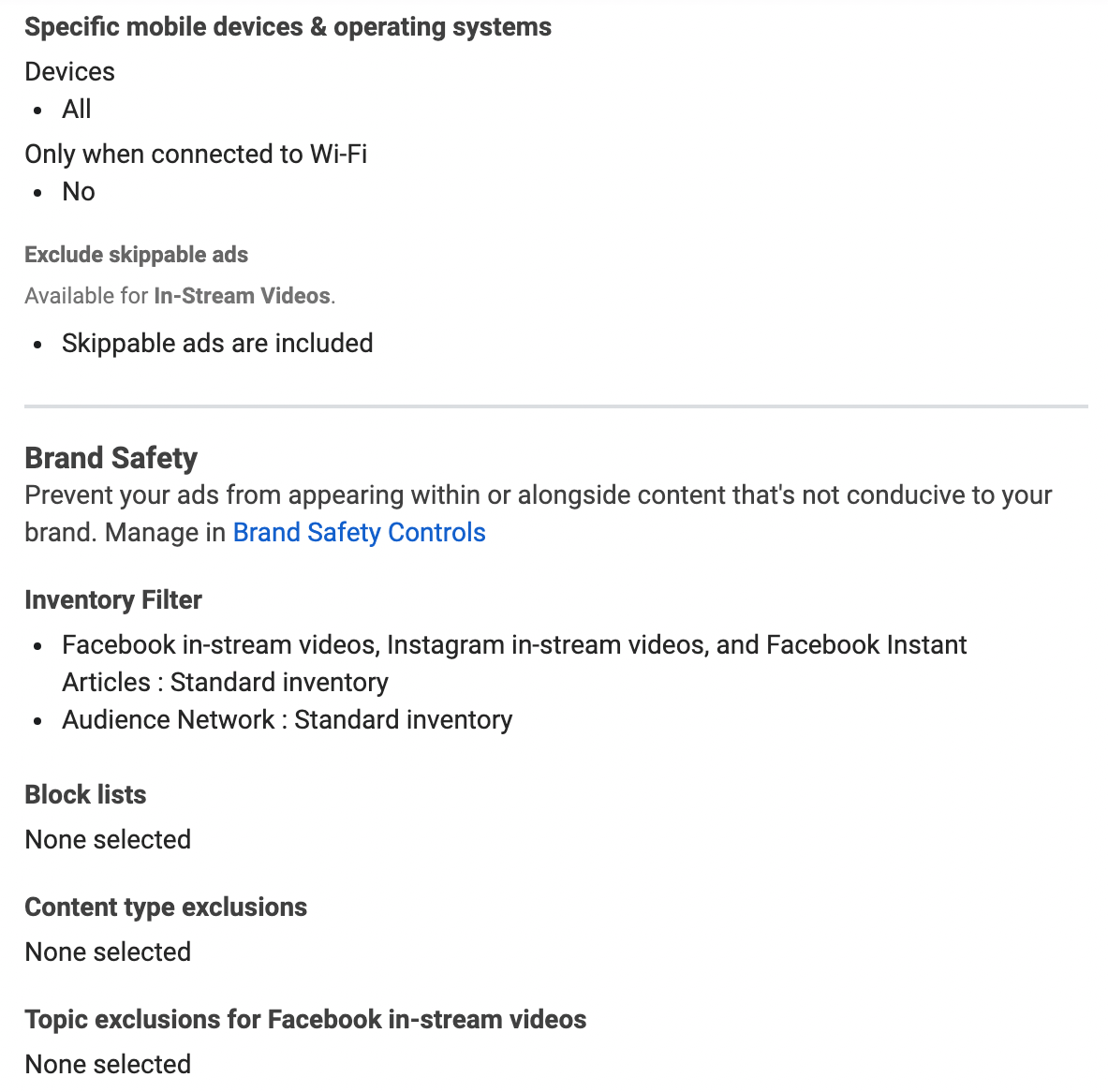
If you're currently advertising only on Facebook or only in the news feed, select more placements or use automated placements to scale more effectively. Ads Manager lets you deliver ads to:
- Facebook, including in the news feed, Facebook Marketplace, Facebook Groups, and search results
- Instagram, including in the feed, Stories, Reels, and the Explore tab
- Messenger, including in the inbox and Stories
- Audience Network, including in videos and instant articles
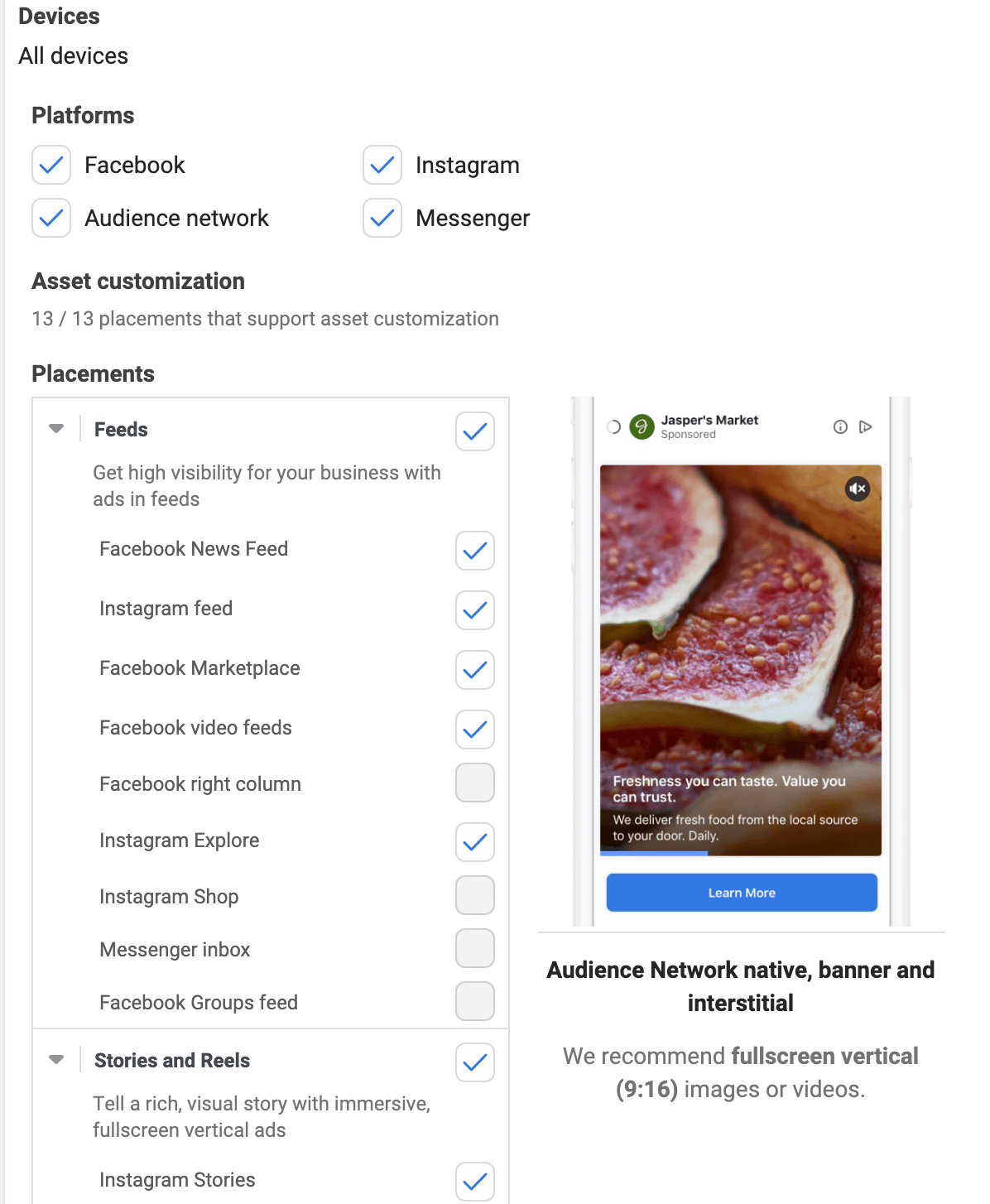
Have you used Ads Manager breakdowns to identify low-performing placements in the past? Keep in mind that Ads Manager now provides placement breakdowns for Facebook-based activity only.
In other words, you can see reach and engagement metrics for individual placements, but you can't see conversion or purchase breakdowns. To scale middle- and top-of-funnel campaigns more efficiently, it's usually best to use automated placements and avoid making decisions based on reach and engagement metrics.
#5: Expand Your Facebook Ad Sets
Even if you maximize ad placements and target broad or lookalike audiences, ad fatigue can make scaling more expensive. If each ad set includes only one or two ads, then your audience is likely to get tired of seeing the same creatives sooner rather than later.
To expand your ad sets and avoid ad fatigue, create new versions for your audience. In many cases, making small modifications to top-performing creatives can keep your audience engaged and make horizontal scaling more affordable. Your ad iterations might include:
- Creating new media options by adding various text overlays or making more video edits and different image crops
- Adding up to five versions of primary text, descriptions, and headlines so the algorithm can deliver the best option
- Changing the call to action to see what drives the most conversions
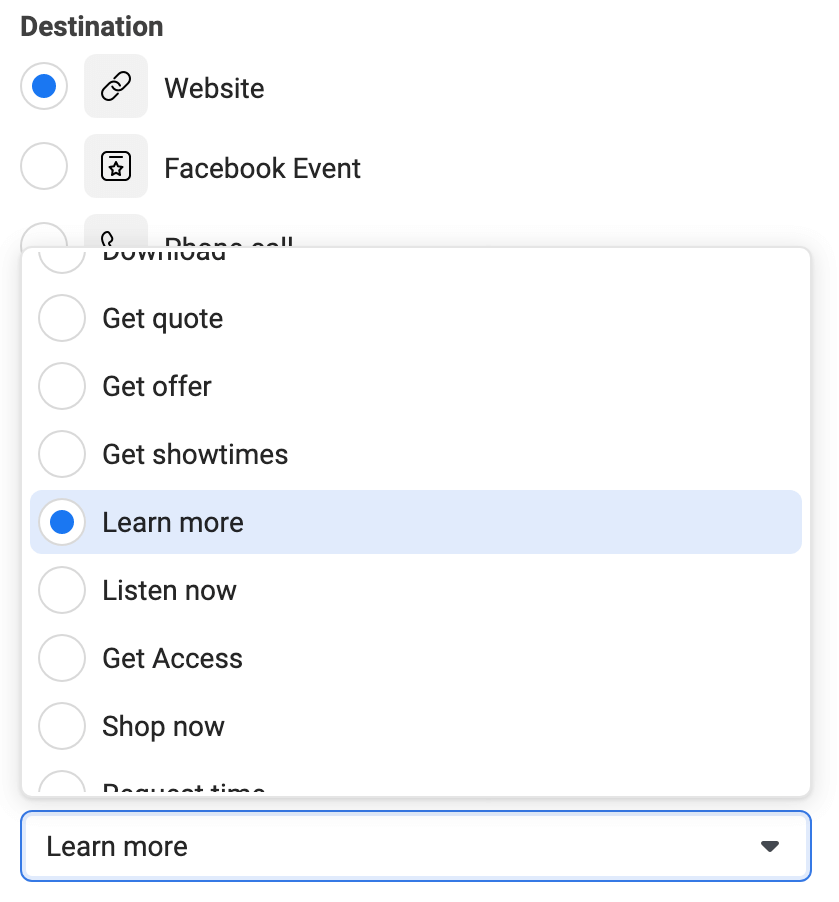
At the ad level, you can also turn on automated options like Optimize Text Per Person and Dynamic Experiences. That way, you can allow the algorithm to deliver the best combination of elements in the optimal order for any audience or placement.
#6: Set Up Automated Rules to Govern Campaign Management
From increasing campaign budgets to adjusting manual bids to testing audience targeting, scaling Facebook ads manually can be incredibly time-consuming. With automated rules, you can save time and streamline ad optimization. You can choose from three types of rules.
Reduce Auction Overlap Rule
Are some of your target audiences too similar to each other? You can use the Reduce Auction Overlap rule to manage ad sets with overlapping audiences. You can turn off affected ad sets, and you also have the option to increase the budget of other ad sets to make up for the decreased spend.

Reduce Audience Fragmentation Rule
Are you testing similar creatives on multiple ad sets? You can use the Reduce Audience Fragmentation rule to combine ad sets, audiences, and budgets automatically for better performance and more efficient spending.
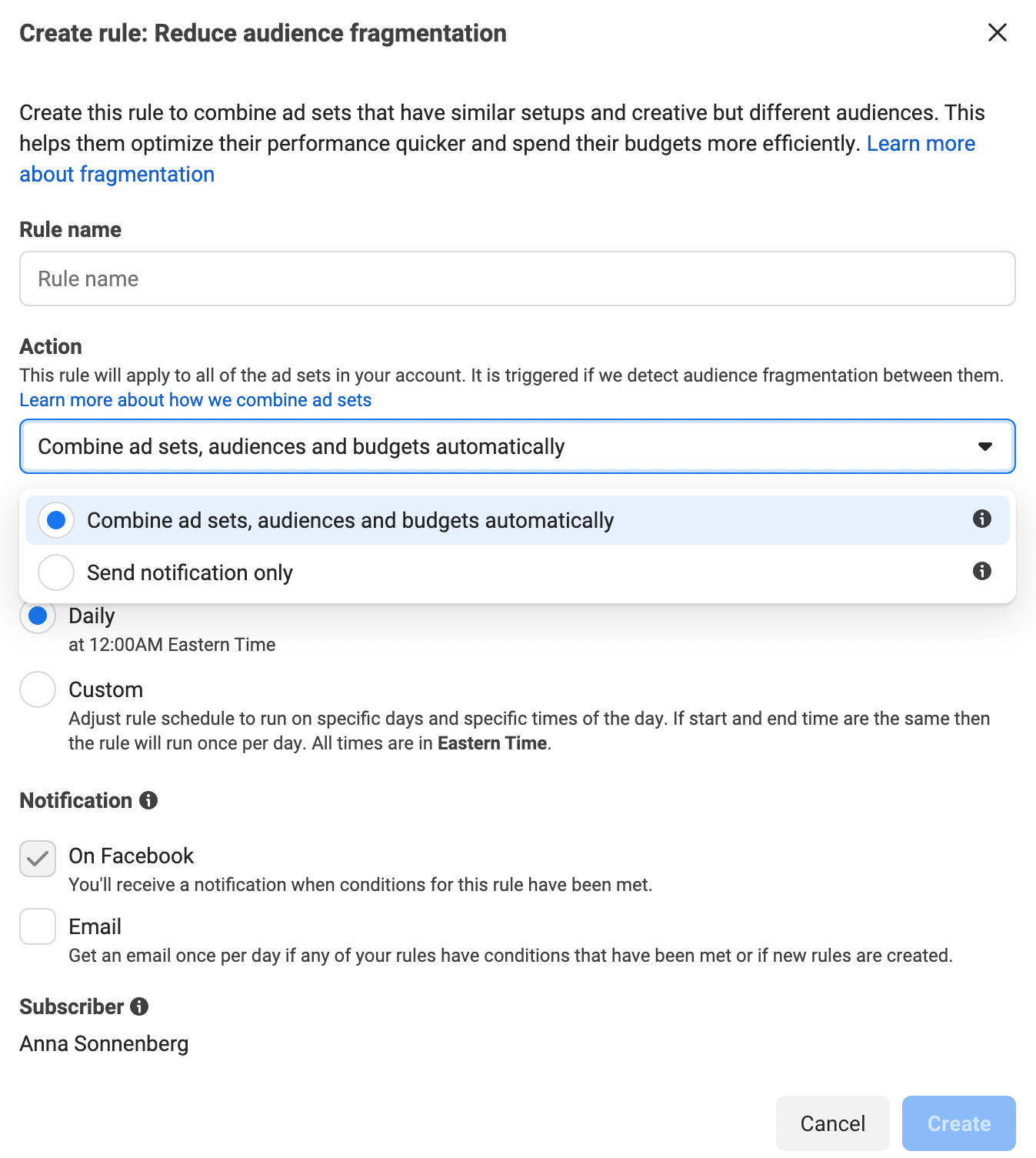
Custom Rules
Do you want to increase campaign budgets automatically? You can use the Custom Rules tool to scale ad spend gradually by setting up a weekly increase dependent on the cost per result.
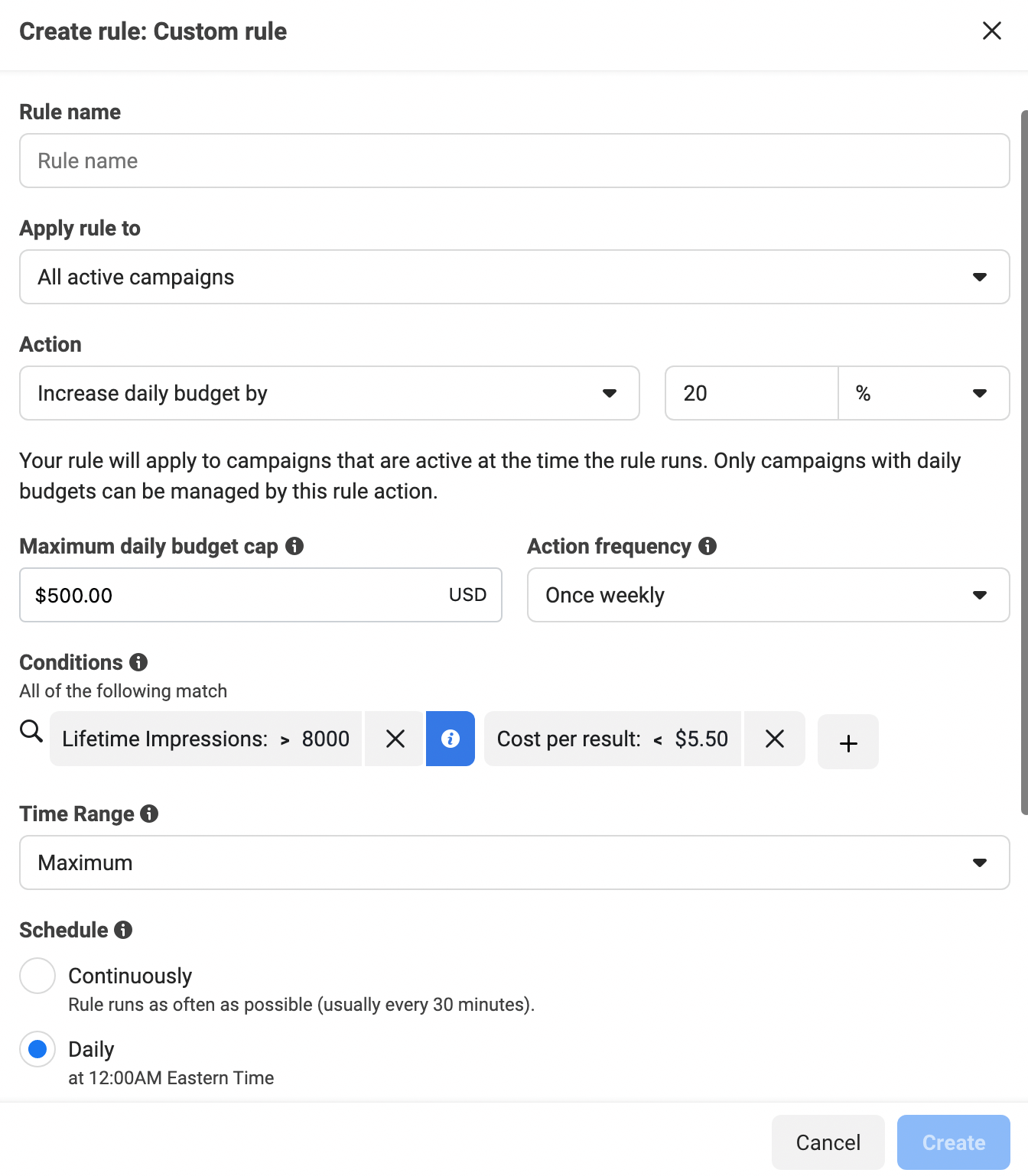
With the Custom Rules tool, you can also make minor adjustments to manual bids. For example, you can optimize performance and scale more efficiently by increasing the manual bid on ads with low impressions.
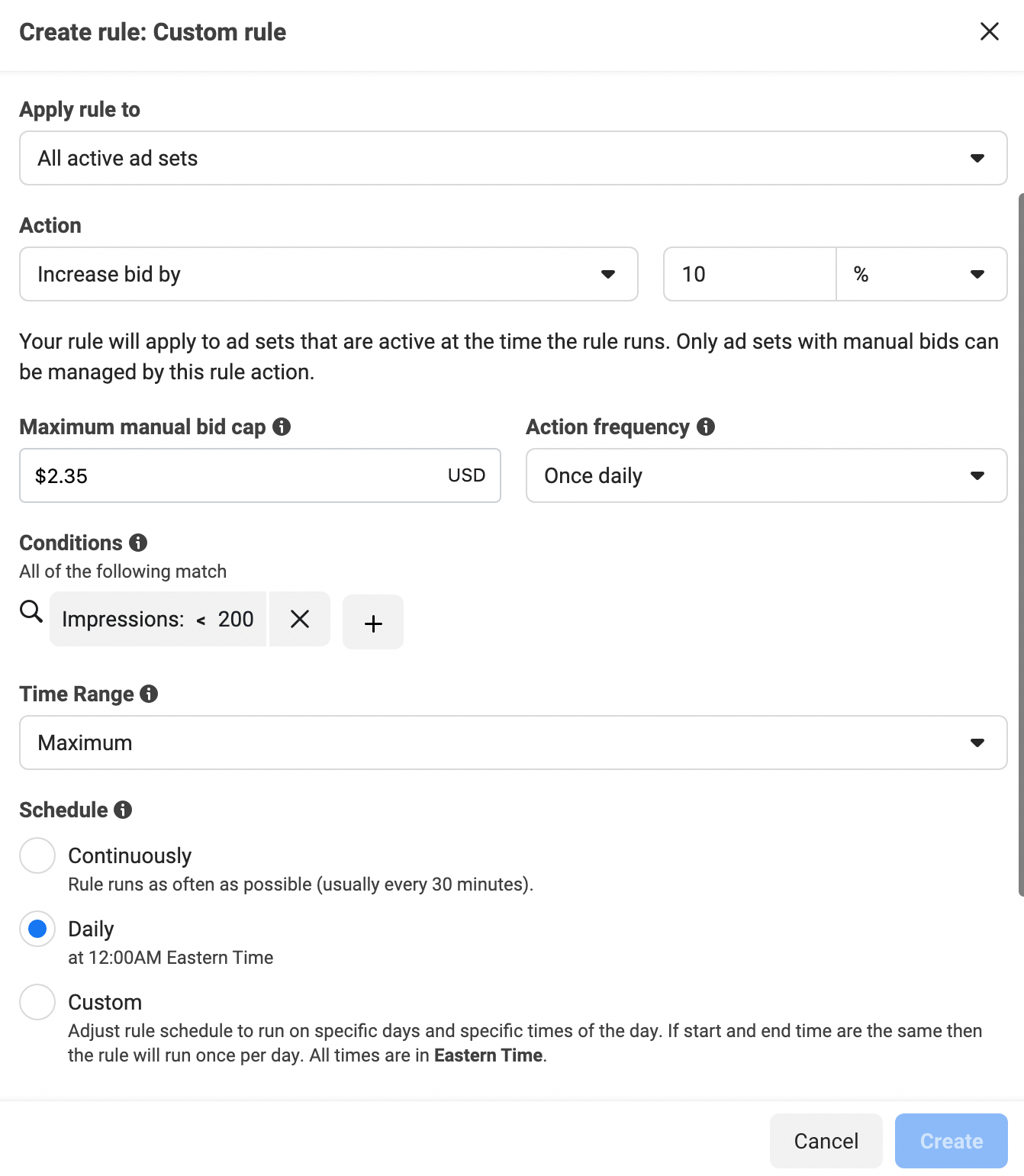
Conclusion
Whether you're planning to scale vertically or horizontally, you have plenty of options for getting better results from your Facebook ad campaigns. From targeting new audiences and testing new creatives to increasing your ad budget and automating ad spend, these tactics can help you scale Facebook ads efficiently.
Get More Advice on Facebook Ads
- Save money on your Facebook ads.
- Track key Facebook ad metrics.
- Improve sales with 10 Facebook ad types.
Stay Up-to-Date: Get New Marketing Articles Delivered to You!
Don't miss out on upcoming social media marketing insights and strategies! Sign up to receive notifications when we publish new articles on Social Media Examiner. Our expertly crafted content will help you stay ahead of the curve and drive results for your business. Click the link below to sign up now and receive our annual report!
Attention Agency Owners, Brand Marketers, and Consultants

Introducing the Marketing Agency Show–our newest podcast designed to explore the struggles of agency marketers.
Join show host and agency owner, Brooke Sellas, as she interviews agency marketers and digs deep into their biggest challenges. Explore topics like navigating rough economic times, leveraging AI, service diversification, client acquisition, and much more.
Just pull up your favorite podcast app, search for Marketing Agency Show and start listening. Or click the button below for more information.

